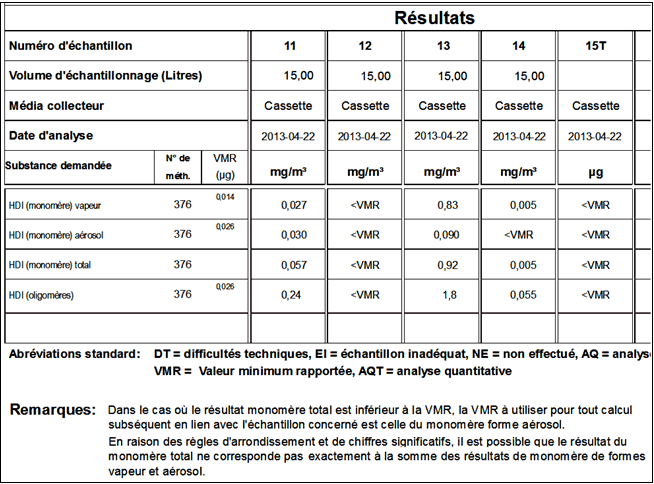New guide is now on line
In the context of an IRSST research project, the Guide for the safe use of isocyanates has been updated and the new version is now available on the IRSST's Web site. The Guide de prévention pour une utilisation sécuritaire des isocyanates – Démarche d’hygiène du travail (Prevention Guide for Safe Use of Isocyanates – Industrial Hygiene Approach, an English version will be available at the end of May 2013) is intended for Québec employers and workers as well as for different occupational health and safety practitioners. Users of the IRSST's laboratory services will benefit from it, mainly due to the concepts of anticipation, identification and evaluation of isocyanate exposure presented in the Guide.
Strongly based on questions from laboratory clientele about isocyanates in recent years, the Environmental Evaluation section of the guide presents a wealth of information aiming, among other things, to help the practitioner select the proper sampling and analytical method to suitably evaluate isocyanate exposure. Currently, the IRSST offers three analytical methods for evaluating isocyanates:
1. IRSST 376 with double filter cassette
2. IRSST 376 with impinger
3. IRSST 366 - high sensitivity
Update of IRSST analytical method 376
The laboratory is taking this opportunity to inform its clientele that the validation data for IRSST analytical method 376 (double filter and impinger) were produced with the result of the new reporting minimum values (RMV) and new coefficients of analytical variance (CVa). Consultation of this new data is possible via the Substance Records from the Workplace Air Contaminant Sampling Guide, more specifically for the following substances: HDI, IPDI, TDI and MDI.
New way of reporting the results for IRSST method 376 – double filter
The type of analytical report produced by IRSST double-filter method 376 was modified so as to differentiate in which physical forms (vapour and/or aerosol) the analyzed isocyanate monomer was present in the air. In fact, the occupational hygiene practitioner may need to know this information, which was not used to its full potential in the presentation of the analytical results.
The two results, vapour form and aerosol form, represent the monomer quantified on the impregnated filter and on the Teflon filter, respectively. It should be noted that only the result representing the sum of the two forms, also reported in the analytical report (total monomer), must be used for comparison to a permissible exposure value. An example of a report is presented in Figure 1 which shows the results produced for HDI as well as the remarks associated with this new report presentation. The reports are not currently available in English. The remarks (remarques) are translated below.

Figure 1. Example of the new presentation for analytical reports produced by IRSST method 376 – double filter.
Text of the remarks in Figure 1:
In the case where the total monomer result is below the RMV (VMR in French), the RMV to be used for any subsequent calculation linked to the sample in question is that of the monomer in aerosol form.
Due to the rules for rounding and for significant digits, the results for total monomer may not correspond exactly to the sum of the results for monomer in vapour and aerosol form.
Simon Aubin, M.Sc., CIH, ROH
Chemist, industrial hygienist
Scientific professional
Lucile Richard
Laboratory technician
Laboratory Division
IRSST